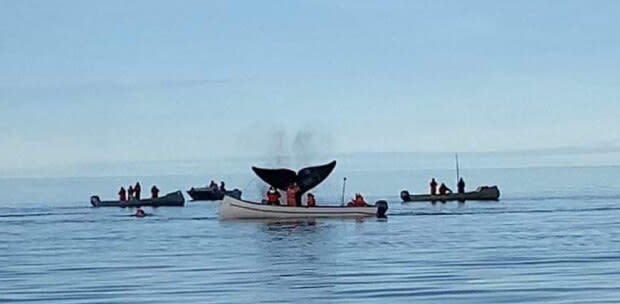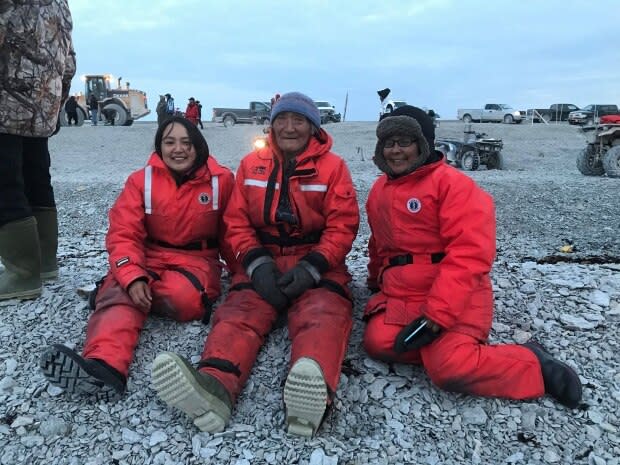'It was a proud moment': Sanirajak celebrates successful bowhead hunt
It isn't the biggest whale he's ever caught, but at 12.5 metres long — that's longer than a school bus — Ike Angotautok says his fourth bowhead hunt was a successful one.
The hunt captain led a crew of 24 people to capture a male bowhead whale on Aug. 1. Angotautok, 60, says it's thanks to a lot of planning from the community of Sanirajak (formerly known as Hall Beach).
There were four boats to hunt the whale, two boats to scout, and two others to act as safety boats if the hunters needed help.
Angotautok says he drove the lead boat, the one that carried the explosive harpoon, while his son and other hunters harpooned bright buoys onto the animal so the hunters could keep track of it in the water.
It was around 8 p.m. when he shot the explosive harpoon into the whale.
Their family, and many others in the community of about 850 people, will have whale to eat for the year, he said.
"My two freezers are full, I got enough for winter," he said.

The hunt crew left to look for a bowhead just after noon hour on Aug. 1.
"That's how you hunt, you go look for them," said Abraham Qammaniq, chair of the community committee that planned the bowhead hunt.
The committee chose experienced hunters, who were used to travelling with each other.
"That made the hunting more efficient and safer," he said. "They know the person they are going to be with ... and don't necessarily need to talk to communicate."
For me, it was an emotional time, thinking of our ancestors. - Abraham Ullalaaq, elder advisor
As one of the crew members on the safety boats, Qammaniq had a "front seat" to watch the hunt itself, he said.
The boats were nearing the community of Igloolik, in the middle of Foxe Basin, when they heard that a bowhead had been sighted back closer to home.
"We received a call over the CB radio, a sighting has happened in front of [Sanirajak]," he said.
So the boats headed back, tracking the whale until they captured it about 15 kilometres from their town.

It took the boaters around five hours to pull the animal to shore, roughly five kilometres from the community, and then another hour to get the whale on to land, said Qammaniq.
The planning committee made sure there were helpers to pitch tents and keep people fed while the bowhead was butchered on Sunday and Monday.
Abraham Ullalaaq was the elder advisor, but it was the first time he was able to get out on the water to hunt for a bowhead.
"It was a proud moment for everyone," he said. "For me, it was an emotional time, thinking of our ancestors and how they were able to hunt for a huge mammal. We all think of our Inuit ancestors at times like this."
Once the butchering was done on Monday, the helpers buried the leftovers that couldn't be used for food or artwork.
But Qammaniq said the skull is still there, placed next to another bowhead skull caught by community hunters years ago.


